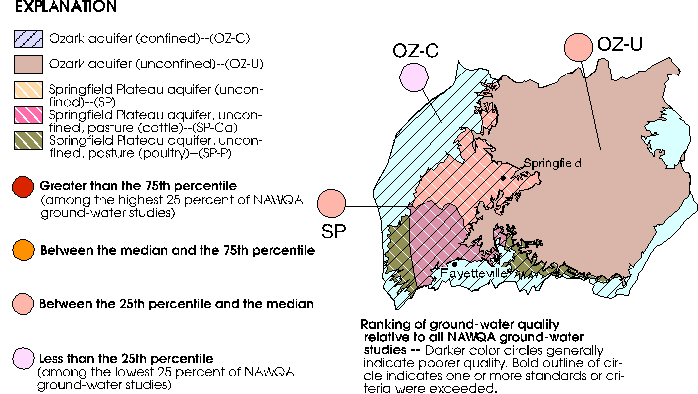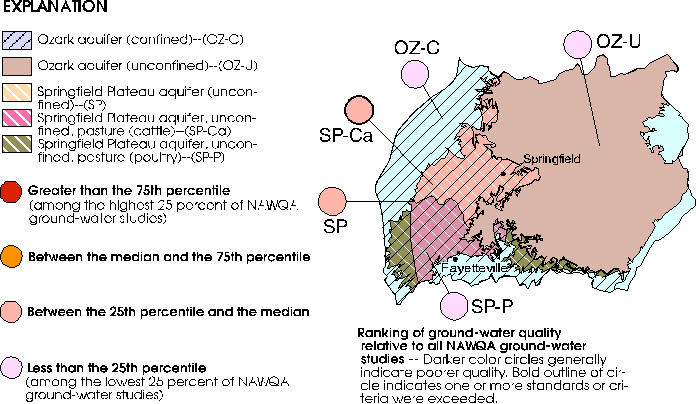|
|
Five major water-quality characteristics were evaluated for ground-water studies in each NAWQA Study Unit. Ground-water resources were divided into two categories: (1) drinking-water aquifers, and (2) shallow ground water (in the Ozark Plateaus Study Unit, generally from wells less than 300 feet deep). Summary scores were computed for each characteristic for all aquifers and shallow ground-water areas that had adequate data. Scores for each aquifer in the Ozark Plateaus Study Unit were compared with scores for all aquifers and shallow ground-water areas sampled in the 20 NAWQA Study Units during 1992-95. Results are summarized by percentiles; higher percentile values generally indicate poorer quality compared with other ground-water studies in the 20 Study Units. Water-quality conditions for each sampled drinking-water aquifer also are compared to established drinking-water standards and criteria for protection of human health. (Methods used to compute rankings and evaluate standards and criteria were described by Gilliom and others, in press.) With the exception of the confined part of the Ozark aquifer (which is not considered shallow ground water), all groups of ground-water data for the Ozark Plateaus Study Unit could have been compared to both the national drinking-water aquifer scores and the national shallow ground-water scores. The results of the drinking-water aquifer comparisons are shown below. |
|
EXPLANATION
|
Ranking of ground- water quality relative to all NAWQA ground-water studies -- Darker colored circles generally indicate poorer quality. Bold outline of circle indicates one or more standards or criteria were exceeded
|

Radon levels in water from the unconfined Springfield Plateau aquifer and the confined and unconfined parts of the Ozark aquifer were lower than levels in most other aquifers in the 20 NAWQA Study Units.

Water from the Ozark aquifer had nitrate concentrations lower than the median value for all NAWQA Study Units. However, water from parts of the Springfield Plateau aquifer, which lies beneath a primarily agricultural area, had higher nitrate concentrations, greater than the national median. U.S. Environmental Protection Agency drinking-water standards were exceeded in less than 1 percent of Springfield Plateau aquifer samples.

Median dissolved-solids concentrations in water from sampled wells were less than the NAWQA national median. However, samples from nearly all groups of data occasionally exceeded the U.S. Environmental Protection Agency drinking-water guideline. A small percentage of the samples from the Springfield Plateau aquifer and unconfined part of the Ozark aquifer had concentrations exceeding the guideline; however, 15 percent of the samples from the confined part of the Ozark aquifer exceeded the guideline. Dissolved-solids concentrations in the confined aquifer were greatest near the western boundary of the Study Unit.

Volatile organic compound (VOC) detections were more frequent in samples from the Springfield Plateau aquifer and part of the Ozark aquifer than in most other drinking-water aquifers sampled nationally by NAWQA. Detections of VOCs did not appear to be related to regional land use, but could be related to very localized land uses at some sites or could be an artifact of well construction or sample collection. Concentrations generally were low relative to detection limits or drinking-water standards or guidelines.

Pesticides were detected less frequently in the Springfield Plateau and Ozark aquifers than in most other drinking-water aquifers in the 20 Study Units. However, pesticides were detected more frequently in water in the Springfield Plateau aquifer (a mostly unconfined aquifer underlying areas with primarily agricultural land use). Concentrations generally were low relative to detection limits and concentrations in other Study Units and exceeded drinking-water standards or guidelines in less than 1 percent of samples.
Compared with other NAWQA Study Units:
Suggested citation:
Petersen, J.C., Adamski, J.C., Bell, Davis, J.V., Femmer, S.R., Freiwald,
D.A., and Joseph, R.L., 1998, U.S. Geological Survey Circular 1158, on
line at < URL: https://water.usgs.gov/pubs/circ1158>, updated
April 3, 1998
This page is a subpage of <URL:http://water.usgs.gov/pubs/circ1158>
Email questions and comments to GS-W_NAWQA_Outreach@usgs.gov
Last modified: 4/3/98